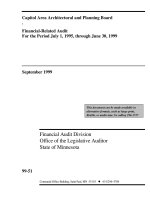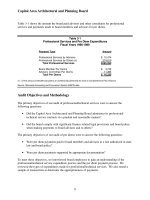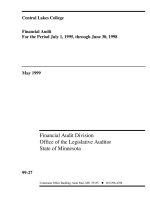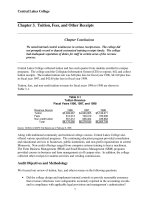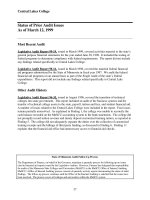Bsi bs en 00623 1 1995 (1999)
Bạn đang xem bản rút gọn của tài liệu. Xem và tải ngay bản đầy đủ của tài liệu tại đây (347.36 KB, 10 trang )
BRITISH STANDARD
Advanced technical
ceramics —
Monolithic ceramics
General and textural
properties —
Part 1: Determination of the presence of
defects by dye penetration tests
The European Standard EN 623-1:1995 has the status of a
British Standard
BS EN
623-1:1995
BS EN 623-1:1995
Committees responsible for this
British Standard
The preparation of this British Standard was entrusted to Technical
Committee RPI/13, Advanced technical ceramics, upon which the following
bodies were represented:
AEA Technology
Aluminium Federation
British Ceramic Research Ltd.
British Industrial Ceramic Manufacturers’ Association
Department of Trade and Industry (National Physical Laboratory)
Flat Glass Manufacturers’ Association
GAMBICA (BEAMA Ltd.)
Institute of Refractories Engineers
Ministry of Defence
Refractories Association of Great Britain
Society of British Aerospace Companies Limited
University of Manchester
This British Standard, having
been prepared under the
direction of the Sector Board for
Materials and Chemicals, was
published under the authority of
the Standards Board and
comes into effect on
15 August 1995
Amendments issued since publication
© BSI 07-1999
Amd. No.
The following BSI references
relate to the work on this
standard:
Committee reference RPI/13
Draft for comment 92/45757 DC
ISBN 0 580 24518 7
Date
Comments
BS EN 623-1:1995
Contents
Committees responsible
National foreword
Foreword
Text of EN 623-1
© BSI 07-1999
Page
Inside front cover
ii
2
3
i
BS EN 623-1:1995
National foreword
This Part of BS EN 623 has been prepared by Technical Committee RPI/13 and
is the English language version of EN 623-1:1995, Advanced technical
ceramics — Monolithic ceramics — General and textural properties —
Part 1 : Determination of the presence of defects by dye penetration tests, published
by the European Committee for Standardization (CEN). This standard
supersedes BS 7134-1.1:1989 which is withdrawn.
EN 623-1 was produced as a result of international discussions in which the UK
took an active part.
Cross-reference
Publication referred to
Corresponding British Standard
ENV 1006:1993
DD ENV 1006:1994 Advanced technical ceramics.
Methods of testing monolithic ceramics. Guidance on the
sampling and selection of test pieces
A British Standard does not purport to include all the necessary provisions of a
contract. Users of British Standards are responsible for their correct application.
Compliance with a British Standard does not of itself confer immunity
from legal obligations.
Summary of pages
This document comprises a front cover, an inside front cover, pages i and ii,
the EN title page, pages 2 to 4, an inside back cover and a back cover.
This standard has been updated (see copyright date) and may have had
amendments incorporated. This will be indicated in the amendment table on the
inside front cover.
ii
© BSI 07-1999
EUROPEAN STANDARD
EN 623-1
NORME EUROPÉENNE
January 1995
EUROPÄISCHE NORM
ICS 81.060.20
Descriptors: Ceramics, quality, liquid penetrant tests, determination, defects, visual examination
English version
Advanced technical ceramics — Monolithic ceramics —
General and textural properties —
Part 1: Determination of the presence of defects by dye
penetration tests
Céramiques techniques avancées —
Céramiques monolithiques — Propriétés
générales et texturales —
Partie 1: Détermination de la présence de
défauts à l’aide d’essai de ressuage
Hochleistungskeramik — Monolithische
Keramik — Allgemeine und strukturelle
Eigenschaften
Teil 1: Prüfung auf Anwesenheit von
Oberflächenfehlern durch
Farbstoffeindringtests
www.bzfxw.com
This European Standard was approved by CEN on 1995-01-04. CEN members
are bound to comply with the CEN/CENELEC Internal Regulations which
stipulate the conditions for giving this European Standard the status of a
national standard without any alteration.
Up-to-date lists and bibliographical references concerning such national
standards may be obtained on application to the Central Secretariat or to any
CEN member.
This European Standard exists in three official versions (English, French,
German). A version in any other language made by translation under the
responsibility of a CEN member into its own language and notified to the
Central Secretariat has the same status as the official versions.
CEN members are the national standards bodies of Austria, Belgium,
Denmark, Finland, France, Germany, Greece, Iceland, Ireland, Italy,
Luxembourg, Netherlands, Norway, Portugal, Spain, Sweden, Switzerland and
United Kingdom.
CEN
European Committee for Standardization
Comité Européen de Normalisation
Europäisches Komitee für Normung
Central Secretariat: rue de Stassart 36, B-1050 Brussels
© 1995 Copyright reserved to CEN members
Ref. No. EN 623-1:1995 E
EN 623-1:1995
Foreword
This European Standard has been prepared by the
Technical Committee CEN/TC 184, Advanced
technical ceramics, the secretariat of which is held
by BSI.
This European Standard shall be given the status of
a national standard, either by publication of an
identical text or by endorsement, at the latest by
July 1995, and conflicting national standards shall
be withdrawn at the latest by July 1995.
According to the CEN/CENELEC Internal
Regulations, the following countries are bound to
implement this European Standard: Austria,
Belgium, Denmark, Finland, France, Germany,
Greece, Iceland, Italy, Luxembourg, Netherlands,
Norway, Portugal, Spain, Sweden, Switzerland,
United Kingdom.
EN 623 consists of four Parts.
— Part 1: Determination of the presence of defects
by dye penetration tests;
— Part 2: Determination of density and porosity;
— Part 3: Determination of grain size (ENV);
— Part 4: Determination of surface roughness
(ENV).
2
Contents
Foreword
1
Scope
2
Normative reference
3
Apparatus
4
Test pieces
5
Procedure
6
Examination
7
Test report
Annex A (informative)
References
Page
2
3
3
3
3
3
4
4
Inside back cover
www.bzfxw.com
© BSI 07-1999
EN 623-1:1995
1 Scope
This Part of EN 623 describes qualitative methods
for determination of the presence of defects in
advanced monolithic technical ceramics by dye
penetration tests. The results are reported as visual
observations of dye penetration.
Three methods are described.
— Method A: A fuchsine dye test (see 5.1) which
is suitable for white or pale coloured ceramic
products, performed using an evacuation
technique.
— Method B: A fluorescent dye test (see 5.2)
which is suitable particularly for those products
where the purple fuchsine has insufficient visual
contrast with the ceramic, performed using a
proprietary test kit.
— Method C: A fuchsine dye test (see 5.3) which
is performed by simple immersion in or spraying
with a dye solution, suitable for routine testing
for major defects.
NOTE 1 It is important to note that these methods allow only
certain types of defects to be detected. Defects which are not
revealed by these methods, but which may influence properties
and performance include cracks or pores not connected to the
surface, inclusions, certain types of grinding damage, and
residual stresses.
NOTE 2 Interpretation of results may become more difficult
with increasing porosity of the test pieces.
NOTE 3 General principles of dye penetration tests may be
found in EN 571-1. A test suitable for high-voltage insulators
using high-pressure dye penetration is cited in IEC 672. This test
is more searching for open porosity than any of the above
methods.
3.3 Open mesh container, fabricated from ceramic or
other non-metallic material, and of size appropriate
to the test pieces (see clause 4).
3.4 For method B, a source of ultraviolet light.
3.5 For method A, an airtight vessel.
3.6 Low power microscope
3.7 Appropriate dye solutions
4 Test pieces
Materials for testing should be sampled in
accordance with the guidance given in ENV 1006.
Test pieces should be whole items, or, where this is
not possible, fragments of ceramic products in which
broken surfaces are exposed.
Where required, test pieces should be conditioned to
remove absorbed organic material, such as grinding
coolant. This may be done by firing in an oxidizing
atmosphere to 600 °C ± 50 °C, maintaining this
temperature for 2 h. If this treatment leads to
annealing or oxidation of the surface of the
test piece, use an alternative treatment,
e.g. 2 h at 400 °C ± 50 °C in a vacuum oven.
www.bzfxw.com
2 Normative reference
This European Standard incorporates by dated or
undated reference, provisions from other
publications. These normative references are cited
at the appropriate places in the text and the
publications are listed hereafter. For dated
references, subsequent amendments to or revisions
of any of these publications apply to this European
Standard only when incorporated in it by
amendment or revision. For undated references, the
latest edition of the publication referred to applies.
ENV 1006, Advanced technical ceramics — Methods
of testing monolithic ceramics — Guidance on the
sampling and selection of test pieces.
3 Apparatus
3.1 For method A, evacuating equipment, capable of
reducing the pressure to a value not greater
than 2 500 Pa, having a means of measuring the
pressure used.
3.2 Drying oven, capable of maintaining a
temperature of 110 °C ± 5 °C.
© BSI 07-1999
5 Procedure
5.1 Method A: Fuchsine dye test using
evacuation
Place the dry test pieces in the container (3.3) and
immerse the container in a solution of fuchsine dye
in industrial methylated spirits [(ethanol)
concentration 16 g/l] contained in an airtight vessel.
NOTE 1 The choice of solvent for the dye may be important in
tests on non-oxide materials. Normally, for oxides, industrial
methylated spirits (ethanol) is adequate, but if problems of
wetting arise it is necessary to experiment with different
solvents. Necessary precautions in handling solvents should be
taken.
Seal the vessel and reduce the pressure using the
evacuating equipment (3.1), until the solution boils.
Maintain this reduced pressure for 5 min.
Allow the contents of the vessel to return to
atmospheric pressure, and remove the test pieces
from the solution. Thoroughly wash the test pieces
with a warm solution of soap or detergent to remove
surface dye.
NOTE 2
Mechanical brushing may be used.
Rinse the test pieces in water, and dry them in air
at 110 °C ± 5 °C.
Examine the test pieces under good illumination, by
eye or with a low power microscope, according to the
size of the features expected.
3
EN 623-1:1995
5.2 Method B: Fluorescent dye test
b) general surface absorption;
Place the dry test pieces in the container (3.3) and
immerse the container in a solution of fluorescent
penetration fluid, obtained from a dye penetration
kit.
NOTE 3 Strong surface absorption of dye, especially
fuchsine dye (see 5.1) is indicative either of surface porosity
in unmachined ceramics only, or of surface damage and
micro-cracking in machined and unmachined ceramics, or
both.
NOTE 1 This test is carried out at ambient temperature and
pressure.
c) no effect.
After 15 min, remove the excess fluid in accordance
with the instruction for the dye kit. Should the
instructions specify a developer, follow the
procedure given so that all surfaces of the test pieces
are evenly coated. Examine the test pieces under
ultraviolet light.
NOTE 2 Ultraviolet lamps should be operated in accordance
with the manufacturer’s safety instructions.
5.3 Method C: Fuchsine dye test using
immersion or spraying
For the immersion test, place the dry test pieces in
the container (3.3) and immerse the container in a
solution of fuchsine dye in industrial methylated
spirits (ethanol) (concentration 16 g/l). See 5.1,
note 1. Alternatively, a fuchsine dye testing kit may
be used. Agitate the container for at least 30 s and
remove from the solution.
For the spraying test, spray the test-pieces with
fuchsine dye solution prepared as above until all
surfaces are well covered. Allow to stand for at
least 30 s.
Thoroughly wash the test-pieces with warm
solution of soap or detergent to remove surface dye.
NOTE 1
Mechanical brushing may be used.
Rinse the test pieces in water and dry them in air
at 110 °C ± 5 °C. If appropriate, apply the dye
testing kit developer.
Examine the test pieces under good illumination, by
eye or with a low power microscope according to the
size of the features expected.
NOTE 2 This procedure is not as rigorous as method A, but is
generally adequate for inspection of significant cracking or
porosity.
NOTE 4 If no effect is observed when testing a material for
the first time, a check on the ability of the solvent to wet the
ceramic is recommended. The solvent should be changed and
the test repeated if there is any doubt.
7 Test report
The test report shall include the following
information:
a) the name of the testing establishment;
b) the date of the test, unique identification of the
report and each page, customer name and
address, and signatory;
c) a reference to this European Standard,
i.e. “Determined in accordance with EN 623-1”;
d) the description of the test material (material
type, manufacturing code, batch number, date of
receipt);
e) the shape and surface condition of the test
pieces, including whether or not they were broken
and the presence of any glaze (see clause 4);
f) any conditioning treatment (see clause 4);
g) the method used (A, B or C, see clause 5)
including any changes made to the choice of
solvent;
h) for method A, the pressure to which the
vacuum chamber was reduced, where
appropriate (see 5.1);
i) means used to examine the test pieces,
including the degree of any magnification;
j) for each test piece, one of the three conditions
described in clause 6, including whether or not
the test piece was broken after testing;
k) comments about the test or test results.
www.bzfxw.com
6 Examination
The presence of dye colouration after any of the tests
is an indication of penetration via cracks or other
defects. The report shall include details of
observations as follows:
a) clearly defined localized or linear penetration
showing the presence of discrete surface defects
or cracks;
NOTE 1 The presence of dye may be confirmed by breaking
the test pieces to observe a cross section.
NOTE 2 The determination of the presence of small
defects (< 50 µm) is uncertain and depends on the techniques
employed.
4
© BSI 07-1999
EN 623-1:1995
Annex A (informative)
References
EN 571-1, Non-destructive testing — Penetrant testing — Part 1: General principles for the examination.
IEC 672, Ceramic and glass insulating products.
www.bzfxw.com
© BSI 07-1999
BS EN
623-1:1995
BSI — British Standards Institution
BSI is the independent national body responsible for preparing
British Standards. It presents the UK view on standards in Europe and at the
international level. It is incorporated by Royal Charter.
Revisions
British Standards are updated by amendment or revision. Users of
British Standards should make sure that they possess the latest amendments or
editions.
It is the constant aim of BSI to improve the quality of our products and services.
We would be grateful if anyone finding an inaccuracy or ambiguity while using
this British Standard would inform the Secretary of the technical committee
responsible, the identity of which can be found on the inside front cover.
Tel: 020 8996 9000. Fax: 020 8996 7400.
BSI offers members an individual updating service called PLUS which ensures
that subscribers automatically receive the latest editions of standards.
Buying standards
Orders for all BSI, international and foreign standards publications should be
addressed to Customer Services. Tel: 020 8996 9001. Fax: 020 8996 7001.
In response to orders for international standards, it is BSI policy to supply the
BSI implementation of those that have been published as British Standards,
unless otherwise requested.
Information on standards
www.bzfxw.com
BSI provides a wide range of information on national, European and
international standards through its Library and its Technical Help to Exporters
Service. Various BSI electronic information services are also available which give
details on all its products and services. Contact the Information Centre.
Tel: 020 8996 7111. Fax: 020 8996 7048.
Subscribing members of BSI are kept up to date with standards developments
and receive substantial discounts on the purchase price of standards. For details
of these and other benefits contact Membership Administration.
Tel: 020 8996 7002. Fax: 020 8996 7001.
Copyright
Copyright subsists in all BSI publications. BSI also holds the copyright, in the
UK, of the publications of the internationalstandardization bodies. Except as
permitted under the Copyright, Designs and Patents Act 1988 no extract may be
reproduced, stored in a retrieval system or transmitted in any form or by any
means – electronic, photocopying, recording or otherwise – without prior written
permission from BSI.
This does not preclude the free use, in the course of implementing the standard,
of necessary details such as symbols, and size, type or grade designations. If these
details are to be used for any other purpose than implementation then the prior
written permission of BSI must be obtained.
BSI
389 Chiswick High Road
London
W4 4AL
If permission is granted, the terms may include royalty payments or a licensing
agreement. Details and advice can be obtained from the Copyright Manager.
Tel: 020 8996 7070.


